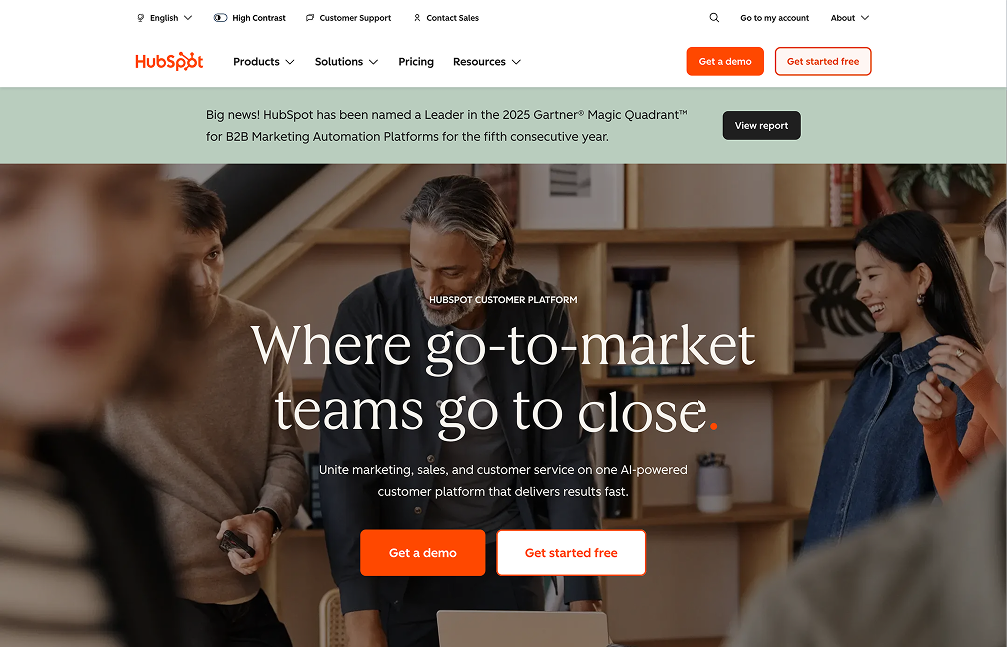You can’t scale what you can’t see. HubSpot is the all-in-one CRM platform that provides a single source of truth for your entire go-to-market motion. By unifying marketing, sales, service, and operations on one easy-to-use platform, HubSpot eliminates the data silos and disjointed customer experiences that kill growth. It’s the strategic choice for scaling businesses that understand that a connected customer journey is a profitable one.
Why HubSpot is the Growth Engine for SMBs
The Power of a Unified Platform: Stop stitching together a dozen different tools. HubSpot’s strength lies in its five interconnected “Hubs”—Marketing, Sales, Service, CMS, and Operations. This native integration means your sales team knows what blog posts a lead has read, your marketing team has visibility into which campaigns are driving revenue, and your service team has the full customer context for every interaction. This alignment is a massive competitive advantage.
Inbound Marketing, Perfected: HubSpot didn’t just build a tool for inbound marketing; they invented the methodology. The platform is purpose-built to attract, engage, and delight customers through valuable content. From SEO and blogging tools to lead nurturing and marketing automation, it provides everything you need to build a predictable, scalable lead generation engine.
Usability Drives Adoption: A CRM is useless if your team doesn’t use it. HubSpot has the most intuitive and user-friendly interface of any major CRM on the market. This dramatically reduces training time, increases adoption rates, and ensures that the data in your CRM is actually accurate and up-to-date.
The Metrics That Define a Connected GTM
- Lead Growth: Companies using HubSpot’s Marketing Hub see an average 121% increase in leads within the first year.
- Sales Productivity: Sales teams using Sales Hub Professional see a 42% increase in deal close rates.
- Efficiency: The all-in-one platform allows teams to replace 4-7 point solutions, reducing software costs and administrative overhead.
- Customer Retention: Businesses using Service Hub see an average 50% improvement in customer response times.
Who Grows with HubSpot
The Ideal Customer Profile:
- Small and medium-sized businesses ($1M - $100M ARR) that are outgrowing basic tools and need a scalable, integrated platform.
- B2B companies with a focus on inbound marketing and a considered sales process.
- Teams that value ease-of-use and want a platform that their sales, marketing, and service reps will actually enjoy using.
- Organizations looking to consolidate their tech stack and create a single view of the customer.
The Decision-Makers:
- CEOs and Founders of scaling companies who need visibility and control over their entire revenue engine.
- VPs of Marketing and Sales who are tired of fighting over lead quality and attribution.
- RevOps Leaders tasked with building a scalable, efficient, and data-driven GTM operation.
- Customer Service Managers who need a 360-degree view of the customer to provide exceptional support.
Common Use Cases That Drive ROI
The Inbound Lead Generation Machine: A visitor finds your blog post via Google, subscribes to your newsletter, downloads an e-book, and is automatically entered into a lead nurturing sequence. Based on their engagement, they are scored and, once qualified, a task is created for a sales rep to follow up. This entire journey is managed and tracked within HubSpot.
The Aligned Sales and Marketing Playbook: The marketing team launches a new campaign for a specific industry. The sales team can see exactly which of their target accounts are engaging with the campaign content in real-time. They use this intelligence to craft highly relevant outreach, referencing the exact content the prospect consumed.
The Seamless Customer Experience: A customer submits a support ticket via a chat bot on your website. The ticket is automatically routed to the correct service agent, who has the customer’s entire history—from their first marketing touch to their most recent purchase—on a single screen, enabling a fast, personalized resolution.
Critical Success Factors
The Pricing Reality Check:
- Free Tools: HubSpot’s free CRM, email, and forms are genuinely powerful and can support a business in its early stages.
- Starter Hubs: Start at ~$20-50/month per Hub, offering a solid entry point for small teams.
- Professional Hubs: This is where the real power lies. Expect to pay $800 - $1,200/month per Hub for the robust automation and reporting features that drive serious ROI.
- The Catch: Pricing is complex, with costs scaling based on the number of marketing contacts, the number of sales/service seats, and which Hubs you subscribe to. Plan your budget carefully.
Implementation Requirements:
- Strategic Onboarding: While technically simple to set up, getting the most out of HubSpot requires a strategic approach. Invest time in defining your processes, properties, and data model before importing your data.
- Embrace the Methodology: HubSpot is a tool built to support a specific (inbound) philosophy. Teams that see the most success are those that embrace this content-first, customer-centric approach.
The Integration Ecosystem
A Center of Gravity for Your Business: HubSpot’s App Marketplace is one of its greatest strengths.
- Massive Ecosystem: With over 1,500 pre-built integrations, it connects to virtually every tool in the modern business stack, from Slack and Zoom to Salesforce and NetSuite.
- Deep Native Integrations: First-party integrations with tools like Google Workspace, Microsoft 365, and LinkedIn Sales Navigator are deep and reliable.
- Developer-Friendly: A robust set of APIs allows for custom integrations to be built for any proprietary systems.
The Bottom Line
HubSpot is the undisputed leader in the SMB market for a reason: it delivers an unmatched combination of power and usability. It provides a clear, scalable path for companies to grow from their first customer to a mature, data-driven organization. While the investment can become significant, the ROI—in the form of increased leads, higher close rates, and improved efficiency—is well-documented and compelling. For most growing businesses, HubSpot is not just a good choice; it’s the right choice.
